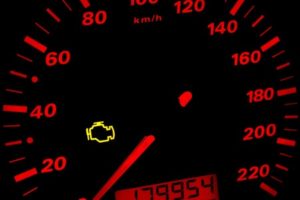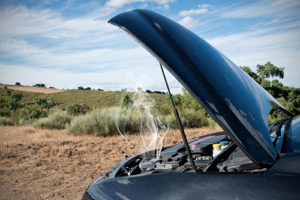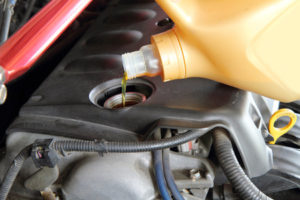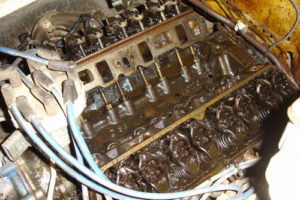Sludge. The word sounds exactly like it looks – thick, dark, and gunky. But what is it? Engine sludge is a buildup of oxidized oil, dirt, and other substances that can have serious consequences for the lifespan of your vehicle. Fortunately, this problem is perfectly preventable. Let’s take a look at how to spot a sludge problem in your car.
Symptoms Of Engine Sludge

1. Your check engine light is on.
There are many possible reasons your check engine light might be on, as we’ve discussed in this article. Engine sludge is another possible reason.
This is because the thickening oil can impact the normal function of components inside your engine, impacting the oxygen sensor readings, causing misfires, and much more. Since there are so many reasons your check engine light is on, it’s best to visit your local mechanic to find the exact cause of the light.

2. Your fuel economy isn’t what it used to be
Your engine has to work harder when it’s being slowed down by sticky, thick sludge, which is why your fuel economy will take a hit. If you haven’t changed your driving habits recently, then a change in miles per gallon is a possible sign of engine sludge.

3. Your check oil light is on
Your check oil light is designed to warn you when your vehicle’s oil is running low. This light should never be ignored, as an insufficient amount of oil in your engine can cause it to overheat or lock up. Your check oil can also be triggered by engine sludge after enough oil in the engine has hardened and caked on to the metal.
Similarly, low oil pressure is another potential sign that your vehicle has an engine sludge problem. Low oil pressure can happen for many reasons, so it’s advisable to see your mechanic as soon as you can to prevent serious damage to your vehicle.
If you’re purchasing a used vehicle, especially one with high mileage, you’ll want to check that the vehicle had regular oil changes. Cars that have been regularly maintained are less likely to have engine sludge.

4. Your car is overheating
The whole purpose of oil is to provide lubrication between the parts inside your engine so that everything can run smoothly.
When your engine has a sludge problem, however, this sticky substance does exactly the opposite, increasing friction between vehicle components. The extra friction creates extra heat, which can make your car overheat.
How To Get Rid of Engine Sludge
There are a couple of ways to get rid of engine sludge.

1. Do an engine flush
This DIY method revolves around using what’s known as a ‘sludge remover’ – a liquid additive that’s designed to be added to your oil, where it helps break down the buildup inside your engine.
Typically, after the additive has been applied, you’ll let the car idle for a while so that the chemicals can reach every component inside the engine and do their magic. Afterwards, you’ll drain the ‘sludge remover’ oil, change the oil filter, and refill the vehicle with good quality oil. Depending on the extent of the sludge, you may need to repeat this process a few times.
An engine flush is not always a certain fix. In addition, as with all aftermarket products, you need to keep in mind that you’re taking some risk in using sludge remover in your engine.

Photo credit: Brad Topar on Flickr.com
2. Take your engine apart and clean it manually
The only surefire way to fully clear out engine sludge is to take the entire engine apart and clean it piece by piece.
This process is time consuming and expensive, which is why preventing engine sludge is the most effective way of avoiding this problem.
Prevent Engine Sludge With T3 Atlanta
You know how the old saying goes – ‘an ounce of prevention is worth a pound of cure’. The same thing is true with engine sludge. Regular oil changes are the best way to keep your engine clean and sludge-free.
With our two convenient metro Atlanta locations and fast, friendly service, T3 Atlanta can help you prevent engine sludge buildup in your engine. Give us a call and we’ll pen you in for an appointment!










Leave a Reply
You must be logged in to post a comment.